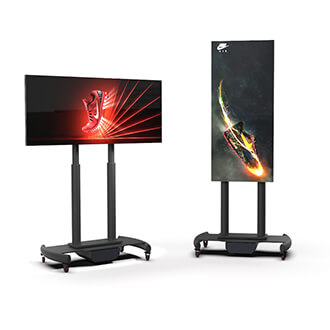Эта статья была написана Тони Тонгом, менеджером по продажам Huasun, и первоначально опубликована в Linkedin.
Проблема 1: явление ореолов
Эта проблема с экранами сканирования внутри помещения заключается в явлении ореолов, которое в основном вызвано зарядкой и разрядкой паразитной емкости на печатной плате во время операции переключения строк и столбцов на экране дисплея. Это приводит к тому, что светодиоды, которые не должны гореть, загораются, особенно при наклонном сканировании, где проблема двоения изображения более выражена. Двоение изображения на светодиодных сканирующих экранах имеет как эффект двоения вверх, так и вниз.

Проблема 2: смещение цвета при низких оттенках серого
Тестовый шаблон, использованный на рисунке 2, представляет собой белый шаблон с низким уровнем оттенков серого. Когда функция предварительной зарядки включена, мы видим, что модуль выглядит красноватым. На рисунке справа показано использование более совершенного чипсета для устранения смещения цвета при включении предварительной зарядки.

Проблема 3: Неравномерность при низких оттенках серого
Неравномерность особенно заметна в условиях низких оттенков серого, что предъявляет очень строгие требования к однородности микросхем драйверов. Предварительная зарядка выполняется для повышения уровней напряжения в рядах и устранения эффекта ореолов вниз. Однако этот метод может привести к проблемам неравномерности в определенных областях. Этот эффект более заметен невооруженным глазом при отображении изображений с низкими оттенками серого. Неравномерность изображений со средними и высокими оттенками серого может быть результатом различий в компоновке печатной платы и различных уровней напряжения из-за несоответствий между микросхемами драйверов. На рисунках 1 и 2 использовалась монохромная тестовая таблица с низким уровнем оттенков серого.

Между светодиодами в одном патче будут отклонения. Сумма таких характеристических отклонений является причиной эффекта размытия экрана. Как показано на рисунках 3 и 4, одни и те же исходные материалы отображаются в полноэкранном режиме. Яркость отдельных пикселей различается и распределяется случайным образом, как показано на рисунке 3, и не демонстрирует значительного улучшения даже при увеличении яркости. Калибровка яркости — эффективный способ исправить эффект размытия экрана. Однако стоимость калибровки яркости высока, и для устаревших светодиодов потребуется повторная калибровка. Другими словами, повторная калибровка будет необходима через регулярные промежутки времени, что приведет к увеличению затрат на техническое обслуживание. Некоторые более совершенные микросхемы используют встроенную коррекцию яркости для создания более равномерной и плавной яркости экрана, как показано на рисунке 4.

Проблема 4: Тусклая линия на первой строке развертки
Дисплей типа сканирования работает следующим образом: светодиоды загораются построчно. Вы заметите, что первая строка сканирования в верхней и средней частях изображения аномально темная; Это явление известно как тусклая линия. Если светодиоды в рамке выключены дольше, чем проводят ток, паразитная емкость в модуле печатной платы приведет к увеличению напряжения на столбце. В частности, напряжение столбца при сканировании и проведении строки 1 будет выше, чем напряжение столбца при сканировании других строк.

Проблема 5: затемненные градиентные линии
Тестовый шаблон на рисунке ниже представляет собой белый градиентный шаблон. Шаблон увеличивается от уровня серого 0 до уровня серого 256 вправо и используется для проверки плавности, линейности и контрастности градиента цветовой шкалы дисплея, определяя, может ли дисплей точно отображать детали изображений при использовании для видеодисплеи.
При использовании этого тестового шаблона тусклая линия при первом сканировании может быть очень четко видна при низких оттенках серого. В правой части изображения показано изображение с плавным изменением уровня серого и сохранением высокой контрастности при устранении тусклых градиентных линий.

Проблема 6: перекрестный эффект, вызванный светодиодами неисправности
Перекрестный узор, образуемый светодиодом неисправности на светодиодном дисплее, может сбить с толку конечных пользователей дисплея. В частности, в случае конструкций с временным мультиплексированием перекрестный узор может образовываться, когда светодиоды, идущие в горизонтальном направлении, ошибочно светятся, а светодиоды, ошибочно светящиеся в вертикальном направлении, вытягиваются пропорционально количеству строк развертки. Поскольку дисплеи с мелким шагом обычно имеют более 16 строк развертки, как только в светодиоде появляется плохой пиксель, появляется четко видимый перекрестный узор, создавая дефект дисплея. Тестовый шаблон, используемый в левой части изображения ниже, представляет собой белый монохромный шаблон наклонного сканирования. Плохой пиксель в светодиоде привел к неисправности светодиода синего света; в результате плохой пиксель становится желтоватым, и виден крест с плохим пикселем в центре.
В правой части рисунка ниже показан реальный тестовый шаблон, в котором перекрестный шаблон удален; видно, что перекрестные явления полностью исчезли.

Проблема 7: Высококонтрастные помехи
Проблема часто возникает в областях, прилегающих к блокам с высокой и низкой яркостью на изображениях, вызывая цветовой оттенок или снижение яркости в частях блока с низкой яркостью. Это явление вызвано взаимными помехами между каналами, и, поскольку оно обычно наблюдается на стыке областей экрана с высокой и низкой яркостью, оно называется «высококонтрастной интерференцией». Высококонтрастные помехи часто встречаются в ситуациях, когда на экране имеется черный фон с белым текстом или в тенях объекта, например, в тенях по краям лица человека. На рисунках ниже показана ситуация, когда на экране возникают высококонтрастные помехи, с видимым цветовым оттенком и пониженной яркостью по краям лица. Правая часть изображения представляет собой нормальное изображение.

Если вы хотите узнать дополнительную информацию, свяжитесь с нами






















